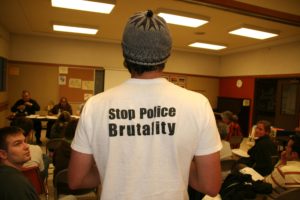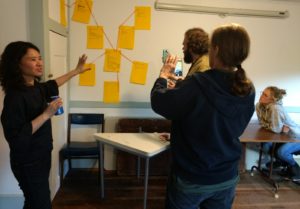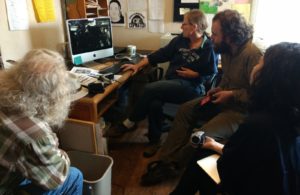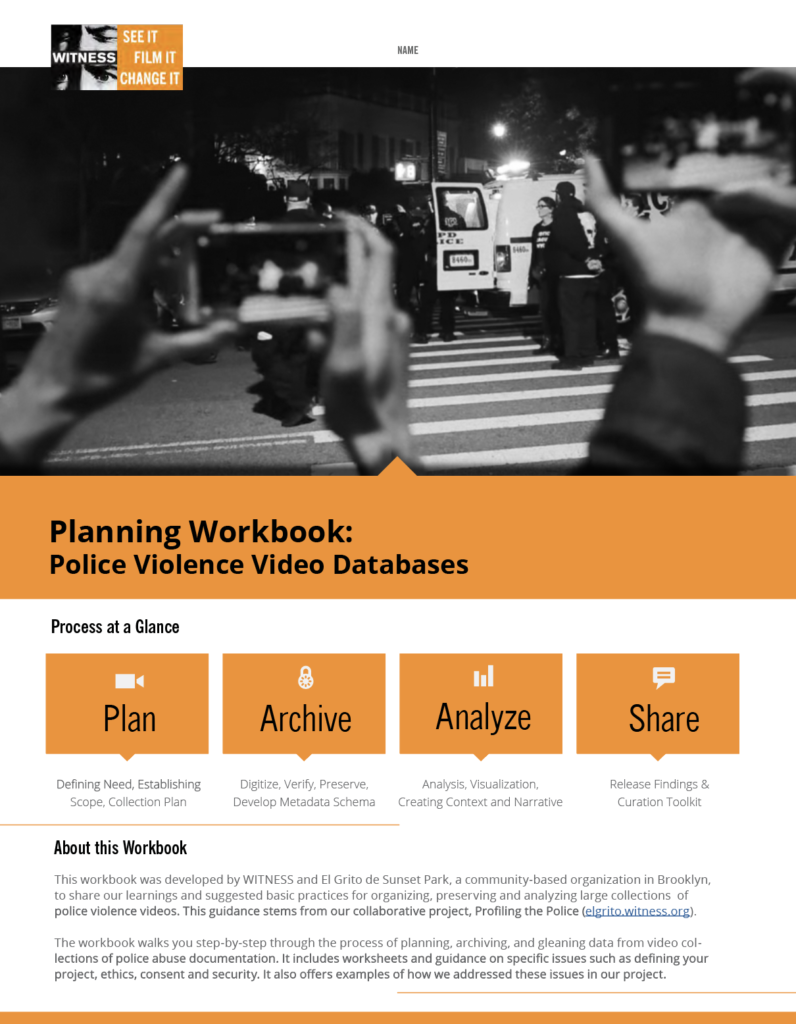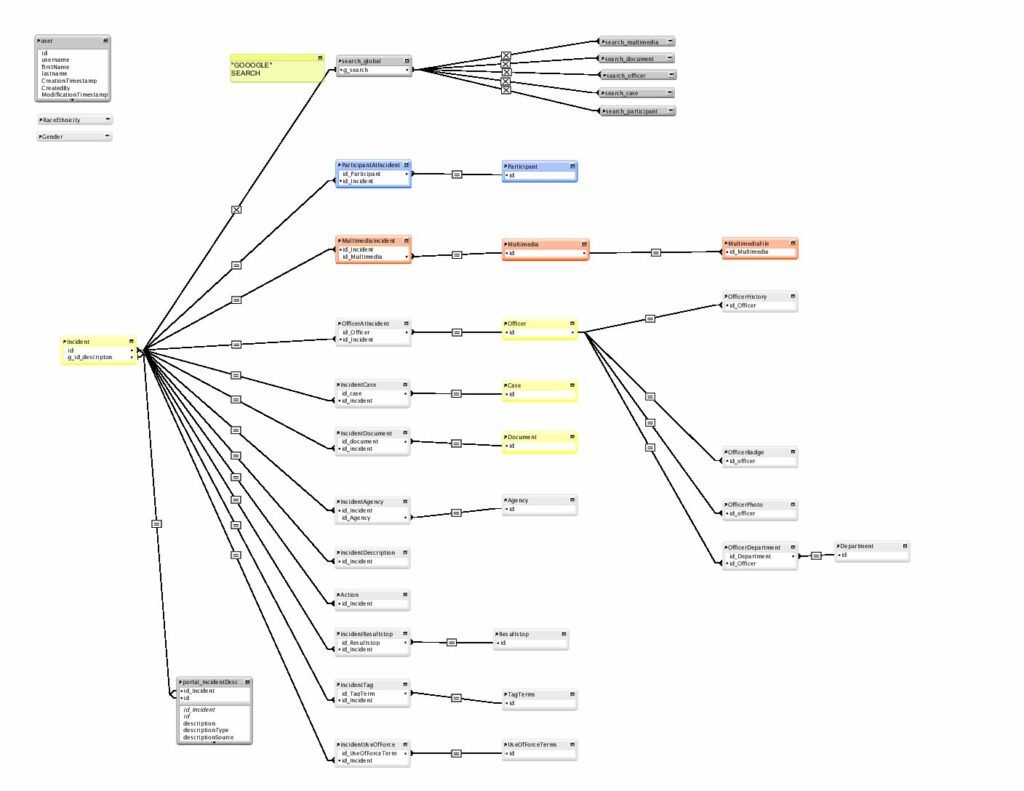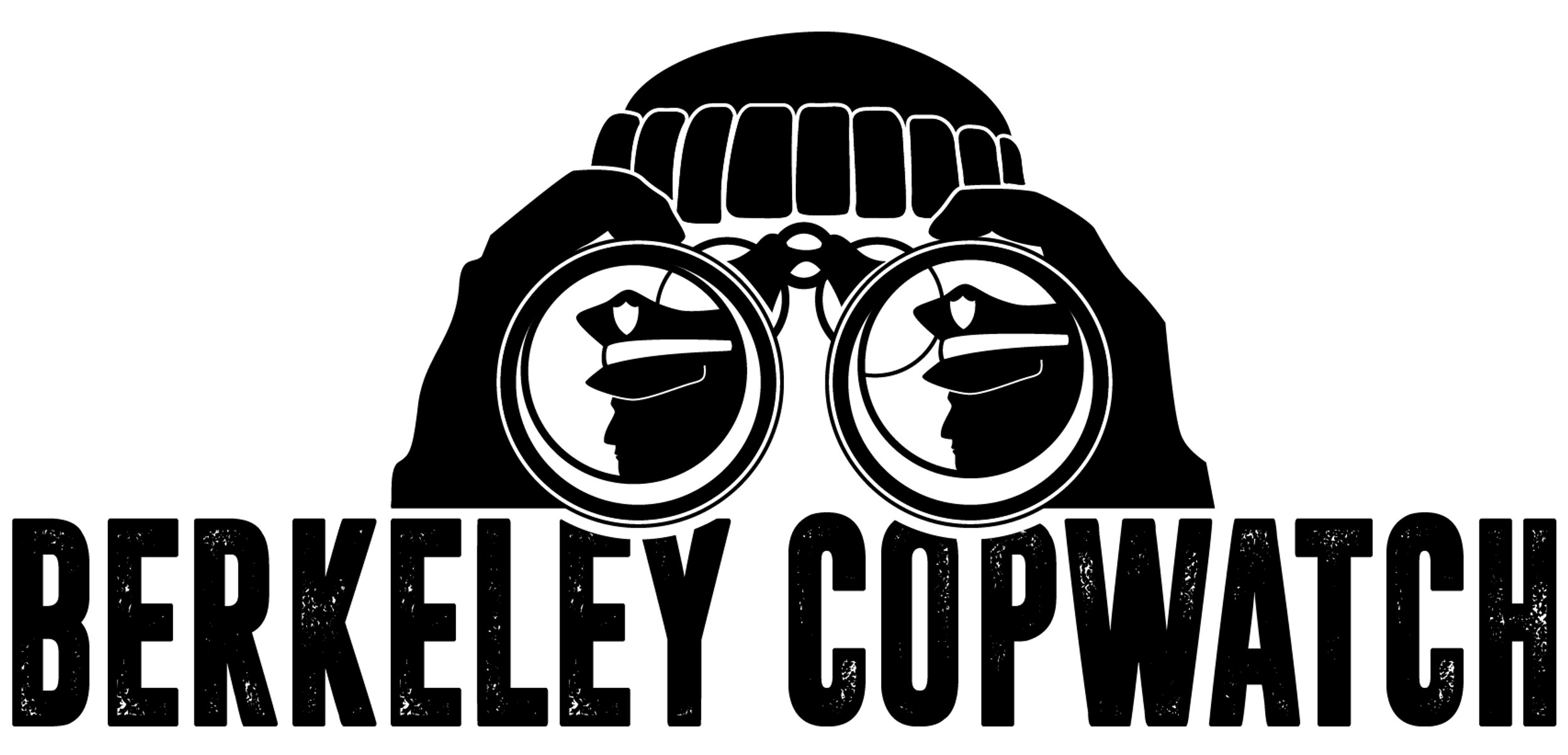
We are excited to share these materials co-developed by WITNESS and Berkeley Copwatch. Continue reading below for more information about this project and a Q&A with Berkeley Copwatch, or jump to the Resources section to download the Planning Workbook, Database Template, Data Dictionary and more.
Check out related articles and guidance on documenting police abuse in our, Caught on Camera: Police Violence in the U.S. project.
May 2023: This page was updated to include Version 2.0 of the Database Template
Introduction
For the past 30 years, the community-based police monitoring group, Berkeley Copwatch (BCW), has been filming police misconduct and serving as a hub for people to gain valuable Know Your Rights information and report abuses by law enforcement. As a volunteer-led group that represents a broad range of ages, abilities, LGBTQ folxs, unhoused individuals, students and local organizers, they have been instrumental in collecting footage and documentation to support legal, advocacy and policy initiatives. Their work has also helped create a rich record of community-led initiatives around issues like gentrification, racism and abusive policing against vulnerable populations like the unhoused community and people living with mental health issues.
Over the past few years, videos of police using excessive force in the United States, including the police killings of Oscar Grant, Eric Garner, Philando Castile, Walter Scott—to name a few—have brought police abuse into the national media spotlight. But despite the conversations, widespread mobilizations and calls for justice that have ensued, little progress has been made in changing the violence, racism and lack of transparency within our law enforcement systems.
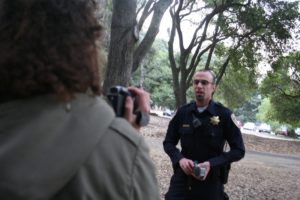 While groups like Berkeley Copwatch are well positioned to expose this type of egregious violence, they also focus on documenting the less publicized daily abuses by police, such as illegal searches, racial profiling and harassment. Videos of these incidents are less likely to make headline news, but careful tracking over time enables advocates to identify officers that are especially problematic, as well as policies that discriminate against and cause harm to community members. The group’s methodical and long-term approach to documentation can impact not just individual cases, but can also deepen our understanding of how these issues play out over time within a community, and systemically within a police department. These efforts are crucial in continuing to speak out against police misconduct, providing support to families and communities affected by this violence, and helping coordinate demands for greater transparency, accountability and finding alternatives to relying on the police.
While groups like Berkeley Copwatch are well positioned to expose this type of egregious violence, they also focus on documenting the less publicized daily abuses by police, such as illegal searches, racial profiling and harassment. Videos of these incidents are less likely to make headline news, but careful tracking over time enables advocates to identify officers that are especially problematic, as well as policies that discriminate against and cause harm to community members. The group’s methodical and long-term approach to documentation can impact not just individual cases, but can also deepen our understanding of how these issues play out over time within a community, and systemically within a police department. These efforts are crucial in continuing to speak out against police misconduct, providing support to families and communities affected by this violence, and helping coordinate demands for greater transparency, accountability and finding alternatives to relying on the police.
Yet, maintaining decades of sensitive documentation in an all volunteer-run organization comes with many complications and difficulties. Berkeley Copwatch is made up of folxs with a wide range of tech abilities, living within a community that is seeing a rapid expansion of gentrification alongside increasingly aggressive police tactics. One major challenge is finding low-cost, secure and sustainable models for collecting, organizing, preserving and curating human rights documentation so it can be used for evidentiary and advocacy purposes. We’ve spoken with a number of other police accountability groups across the U.S. who are facing these hurdles, and they are issues we previously explored in our Profiling the Police project with El Grito de Sunset Park in Brooklyn, NY. Groups collecting documentation of political violence and war crimes in places like Argentina, Syria, Burma and West Papua have expressed grappling with these challenges as well.
While there is no easy solution to resolving these issues, WITNESS has spent the past two years collaborating with Berkeley Copwatch around the development of a People’s Database and archive. The objective of this project has been to streamline their workflows, develop important protocols and policies for users, and strengthen their platforms for collecting, organizing and analyzing data in ways that make the information more useful to individuals, lawyers, journalists and advocates. This Database is not intended to be put online or made public because of privacy and security issues. Rather it serves as an internal resource for the group, and the information will be used for organizing purposes and shared with trusted sources and community members upon request.
We are deeply grateful to the immense amounts of time and energy that Berkeley Copwatch volunteers have invested in this project and heartened by the ways these tools have already had an impact on campaigns to get problematic officers fired and influence policy decisions around emergency mental health response. Read more about the group’s history and how they’re using the database in the Q&A below.
Watch this short video about the People’s Database!
What’s Next?
The Database will continue to grow and evolve over time. We built these tools with the objective of strengthening collaborations between police accountability groups and supporting others to use and adapt the materials in their human rights documentation work. To further those efforts we’re planning to:
- Collaborate with designers and open source developers to enhance the Database usability and look of the interface
- Host a series of webinars and group conversations about the resources
- Share these materials and learnings in different organizing, academic and conference spaces
- If you use or adapt these resources, please let us know so we can continue to share them and understand how they are being put into action!
Updates as of May 2023:
- After much testing, questioning and tinkering, we’re excited to publish Version 2.0 of the Database template!
- As part of this initiative, WITNESS has co-organized several convenings related to Obtaining, Organizing and Opening Police Misconduct Data. Read more about these convenings and download the report from our 2021 virtual gathering with 60+ activists, journalists, lawyers and data scientists.
If you would like to get involved, learn more or support these efforts, get in touch with berkeleycopwatch [@] yahoo.com or check the Berkeley Copwatch Facebook page for regular updates.
The use of a database is crucial to moving the work of copwatch-type groups forward. We are less able to influence behavior with the mere presence of a recording device. We have to make good on our commitment to hold police accountable. We have to document their abuses and ensure that these deeds follow them throughout their career.
Q: What is Copwatch? How did Berkeley Copwatch (BCW) get started?
Berkeley Copwatch is the original “Copwatch” group that began in 1990 in the area along Telegraph Avenue, just south of the UC Berkeley campus. In response to flyers and word of mouth invitations, students, homeless people, activists and neighbors gathered to create a united response to stop abuses by individual officers as well as confront the forces of gentrification that were converging on our neighborhood.
The main goal of Copwatch was to empower our community to stop abuse by police. This requires two main objectives: holding police accountable and fostering alternatives to police. Over the past three decades, we have practiced, developed and shared our approach to holding police accountable, taught thousands of people how to copwatch safely and challenged unjust or abusive police policies and practices that we observed. Our approach relies exclusively on local, volunteer participation to directly monitor and report on police activity and police encounters with the public. Over time, our approach has become less dependent on individual on-site resistance to police misconduct beyond documentation, and more reliant on our ability to access evidence that we can produce quickly and use strategically after the incident is “over”.
As we celebrate the 30th year of Berkeley Copwatch, we are elated to know that there are similar groups all across the nation and on at least three continents. (Our plans for an international Copwatch Gathering have been delayed until Spring 2021, but we are determined to gather copwatchers from across the U.S. and beyond. See www.berkeleycopwatch.org for updates.)
Q: Why is creating a database and archive important for BCW?
As Copwatch matured, it was clear that we needed to raise the standard of information that we gathered and our ability to use it in support of various policy campaigns. We needed to be able to find the footage and aggregate incidents in order to demonstrate patterns of abuse. In addition, we were moving away from the idea that we could shame or change a police department by finding one high profile, outrageous incident that would somehow cause the transformation of the department. We realized that people in our city also suffered from the less dramatic, but still impactful daily abuses such as illegal searches, punitive destruction of property, racial profiling, illegal towing, as well as instances of unnecessary force and more. These patterns of enforcement required that we be able to substantiate our concerns with aggregated footage/data and be able to gather all of this information together in an organized and comprehensive way, sometimes quickly.
Q: What impact has the database had on your advocacy work so far?
One example is the way we’ve been able to influence policy discussions of the Berkeley Mental Health Commission by working with various commissioners to show them footage of police use of spit hoods and the police role in mental health emergencies. Beyond collecting documentation, we have taken action by demonstrating against spit hoods at City Council meetings and calling for a full ban on the dehumanizing and sometimes fatal use of this tactic.
Another example of how it’s supported our work is the case of a UC Berkeley cop, Sean Aranas, who abused homeless people for years was spotlighted in our compilation of many separate incidents of his gross misconduct. He “retired” within two months of the release of our footage.
As noted in the Oakland Reporter, “While Aranas was considered particularly problematic among many homeless people in Berkeley, advocates see his actions as part of a broader pattern of hostility toward homeless people by city and university police, one driven in part by local business owners.”
Without a plan for the organization of our footage, it simply rests quietly and uselessly on a hard drive somewhere. We believe that we have created a user friendly way to collect, maintain and retrieve information as we need it.
Q: In what ways have you been able to engage the broader community with the database?
Berkeley Copwatch has always worked to engage the student body around issues relevant to the community that exists off campus. Since the founding of Copwatch 30 years ago, Andrea Prichett has trained generations of student facilitators for the course entitled, “Copwatch: Community-Based Police Accountability”. The course begins with a Know-Your-Rights Training, then delves into the history of policing as rooted in white supremacy and derived from slave patrols, and continues with a critical analysis of contemporary, local, and international issues related to policing. The Copwatch course also requires students to participate in at least three copwatch shifts, in which experienced volunteers accompany students and community members to film the police. Every semester, Copwatch also gets a few new volunteers from among the students in the course.
In addition to offering an accredited university course for students, Berkeley Copwatch partnered with Dr. Nikki Jones’ Criminal Justice in the Community course to engage students in the process of community-based police accountability. The class of over 80 undergraduates at UC Berkeley worked in small groups to analyze Copwatch footage from the early 2000s. Using an online version of the database developed in AirTable, students recorded incident information, identified officers in the videos, and helped Copwatch troubleshoot the Controlled Vocabulary and Data Dictionary. Ultimately, Copwatch volunteers will transfer the data from the AirTable to the database, which has identical input information. In their reflections, students were excited about the potential of the database as a tool for community-based police accountability, and many described how useful the platform would be for the communities they grew up in.
Students in both courses gain knowledge of their rights when encountering the police, and of the appropriate tactics to copwatch safely. Whenever we run into former students, the first thing they do is tell us about the latest incident that they copwatched! We encourage former, current, and curious students to send us whatever copwatching footage they collect around the city.
Q: How were you organizing your materials before this project? What are some of the biggest challenges you’ve encountered?
In 1993, the Center for Third World Organizing (CTWO) provided Berkeley Copwatch with a floppy disc that had a version of a database in FileMaker Pro format on it. Over time, it became clear that there were too many obstacles to making that database work. Back then, we were using VHS tapes, then to DVD and the mini-DVD, etc. These analogue versions required a lot of volunteer labor to review and label. We could not customize that database to meet our unique needs. The analogue tapes were sometimes renumbered by eager, new volunteers and the incident reports no longer reliably connected to the footage of a particular incident. Volunteers stopped using the database, and our ability to produce recorded information became increasingly dependent on the individual copwatcher’s memory to locate it and less on an internal protocol. This is problematic when you are trying to locate evidence from an incident that happened two years ago but is going to trial next week. Requests for information went unanswered many times because we were not able to locate the information quickly enough.
The biggest challenge in creating this kind of a database was that the people with the technical expertise had to really understand how Copwatchers gather data in order to create a relevant database with protocols that worked easily into the ecology of copwatching as done by both short and long term volunteers. Of course it was extremely challenging to account for the various levels of technical sophistication within the group, provide in-service training to volunteer copwatchers so we could use the system and then hold ourselves accountable to implementing or changing the protocols that we all had a hand in developing.
Q: What would you share with other groups interested in developing community-centered archives and databases?
The use of a database is crucial to moving the work of copwatch-type groups forward. We are less able to influence behavior with the mere presence of a recording device. We have to make good on the threat to hold police accountable. We have to document their abuses and ensure that these deeds follow them throughout their career. We may not get justice in a complaint process or even in court, but a collection of footage that is accessible to the public and contains information on individual officers’ histories as well as cataloged footage that demonstrates the impact of specific police practices is a solid first step. We need to get around the lack of transparency and disclosure in how departments release information to the public. We need to infuse copwatching with renewed purpose and value by connecting each person who stops to watch with a place to send their footage so we can preserve it and gather it with related incidents and use it strategically. There was a tremendous amount of work involved in setting up this system, and we still have a long way to go. We have already used our newly curated footage in justice campaigns.
Project Goals
This work has been customized to fit the needs of Berkeley Copwatch, but we believe these tools can help Copwatch and other human rights monitoring groups in developing a data management system of their own. Hopefully, other community based accountability projects will benefit from the years of informed practice and careful consideration that went into the design of these tools and also feel able to adapt them to be useful in their own cultural, economic and geographic situation and location.
Some of our top objectives for this project were:
- Creating a customized database that could meet the diverse needs and user types within the organization
- Using tools that were low-cost, accessible and as secure as possible
- Documenting our learnings and processes so we could share them with other groups working on similar issues
Process Summary
Our team for this project was made up of archivists, activists, grassroots organizers and students with a wide range of technical experience and familiarity with using databases. We started by understanding the overall needs and challenges that Berkeley Copwatch was facing and how they collect, enter and use data and footage. We workshopped what questions they envisioned being able to “ask” the database, as this would inform how we would structure the database and design its user interface. For example, we determined that Berkeley Copwatch wanted to be able to query details about individual incidents, but also wanted to be able to look into the history of each officer who was involved in an incident. Using this assessment, we mapped out a metadata structure that could be realized in whatever database platform or application we decided to use, then we sat with it, and mapped it out some more.
Andrea Prichett of Berkeley Copwatch reflected on this process,
“In order to answer the question of ‘what did we want to ‘ask’ the database?’, our group had to look inward and be mindful of what we wanted to focus our efforts on as copwatch. We had to review our core beliefs and goals. When we were able to answer ‘what we wanted to focus on’ as an organization, then we better understood what questions or what information we wanted to be able to ‘ask’ the database. That has guided our approach to the design of the database from our POV.”
While it is proprietary and not free, FileMakerPro ended up being the best option for a database app for the group because it has a one-time cost ($594 for an individual license) and is user-friendly and highly customizable. The template also works on FileMaker Cloud, which starts at $1260/year.
Filemaker has a large and diverse user base, so there is a lot of documentation and many online user forums. For security purposes, we chose to keep the data offline by having the database live on a dedicated computer with dedicated local hard drives for video and document storage, plus several backup drives. While there are instances where it would be helpful to have this database run and data stored on a cloud or more distributed system, ultimately the group chose to prioritize security and cost over using a corporate owned cloud service like Google or Amazon.
As the technical aspects of the project were coming together, Berkeley Copwatch spent time cleaning up old data and discussing policies around what information is collected, how long it is stored, and the importance of creating guidance and documentation for the many volunteers that would be using the platform. From these conversations we began drafting a:
- User-handbook, outlining things like internal protocol for using the database, what content to accept and what not to, and ethical and security considerations
- Controlled vocabulary, which is a list of agreed-upon terms that you use in a database, like in dropdown lists
- Data dictionary, which is like a map or rulebook for what the different data elements mean and how to enter them in a database
Throughout this process we spent a lot of time brainstorming, testing, tinkering, re-trying and re-evaluating. There were times that we felt stumped by things like metadata relationships, how to define key terms and how to best organize media folders. But there have also been big and small successes as we came to a consensus on the way forward, as workflows fell into place, or as officers’ profiles evolved to contain photo galleries and badge number histories–demonstrating their ascendence within a department over time. These materials are a work in progress, and likely always will be as needs change, volunteers cycle through and policing tactics evolve.
Watch this introductory webinar by Berkeley Copwatch and WITNESS to learn more about the database and collaboration (you can also download the PowerPoint presentation here).
A note about using these materials
Update May 2023: We have released Version 2.0 of the People’s Database for Police Accountability Template. We’ve also included an updated data model diagram and video walkthrough.
May 2020: The resources below were customized to fit the needs of Berkeley Copwatch. We are sharing them “as is” in the hopes that they can serve as a strong foundation for other copwatch groups and human rights monitors to tailor and adapt for the particulars of their work. These materials are Version 1.0 and we will update these materials when new content or versions are available. We did not to publish the Berkeley Copwatch user-guide because it contains sensitive information about their policies. To learn more or contact us about this project, please get in touch at berkeleycopwatch [@] yahoo.com.
Getting Started Workbook
The needs for starting a database project will differ for every group and depend on the available resources, capacity and scale of the project. Needs can range from acquiring specific technical equipment to making time for intensive conversations around ethics, security and objectives. Below is a short list of some of the tech items that are useful to have, as well as a downloadable workbook to help guide you through some of the nuanced conversations you should plan to engage in as a group.
Technical needs for collecting and storing footage and documentation:
-
Computer
-
Hard drives for storing/backing up video footage
- Cables and adapters to enable uploading footage from cell phones
To use this database template, we recommend you have:
- FileMaker Pro (If this isn’t an option, you can try using a spreadsheet or adapting the data models below in another platform of your choosing)
- Someone who is familiar with or willing to learn FileMaker Pro
- Data Dictionary
- Controlled Vocabulary
- Guidance for volunteers on how to use the database and protocol for adding new content
This downloadable planning workbook is a useful first step for planning a database project. It provides guidance and examples for:
- Developing collection and retention policies
- Guidance on ethics and consent
- Developing verification protocol
- Legal and security considerations
This workbook comes from our Profiling the Police project and Activists’ Guide to Developing Databases Toolkit, a collaboration between WITNESS and El Grito de Sunset Park. This project served as an important foundation for our work with Berkeley Copwatch.
Data Model
The diagram and database design document below describe the structure of the Berkeley Copwatch database V 2.0 (e.g. the tables, fields or elements, and the relationships between tables), which can be implemented in any relational database application. You can also adapt this model to suit your own needs. When designing a data model, consider what questions you want to “ask” the database, and what information you want to get out of the database. Also, be realistic about what data you can actually access or create. This will inform what data you include, how that data is structured and will help ensure you don’t include a lot of tables and fields that are required to fill out but don’t serve your goals.
Learn more about working with metadata and data models in the Metadata section of our Activists’ Guide to Creating Video Databases, or check out our presentation on Databases & Data Models 101.
FileMaker Pro Template
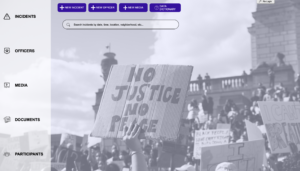
Home screen for People’s Database Template 2.0
Below is a Filemaker Pro file (.fmp12) based on the People’s Database that can be used as a “starter solution” template, or basis for adaptation, by others. It includes all of the tables, relationships, and fields used in the People’s Database (but no records), and various layouts/interfaces for entering, searching, and viewing your own data. We are offering this template “as is” and can’t guarantee that everything will work perfectly.
Using the Template
- You need to have Filemaker Pro installed on your computer in order to open/use this file.
- To access the template, use login “admin” with no password.
- You can access Filemaker’s documentation and various online forums–also, just Googling “Filemaker” and the information you’re looking for usually returns useful answers.
See below for an introductory webinar by Berkeley Copwatch and WITNESS to learn more about the database and collaboration (note, this is presenting Version 1 of the database). You can also download the PowerPoint presentation here). Also check out our video walkthrough of the Version 2 of the database.
Data Dictionary & Controlled Vocabulary
To support the Berkeley Copwatch volunteers in using the database and to ensure as much consistent data entry as possible, we created a Data Dictionary and Controlled Vocabulary that outline what data is included, how it is structured and how it is defined.
We originally created this document using Dropbox Paper and are making the public downloadable version available as a PDF and Word file.
What are these and how are they used?
A data dictionary is basically a rulebook for what data is included in your database, how it is structured, how it is entered, and how it is allowed to be accessed. Just like a regular dictionary, each database field has an entry in the data dictionary, with a clear definition and rules. Data dictionaries are essential for building and using databases, especially when multiple people are involved. A database designer or administrator, for example, will use the data dictionary to set-up tables and fields correctly in a database app, while catalogers will use the data dictionary to make sure they enter information consistently for each record.
A controlled vocabulary is a set of words/terms whose meanings and uses are agreed-upon by your group so that you can catalog and find information efficiently and consistently. You need controlled vocabularies, for example, in order to create dropdown lists in your database. What terms do you want to include or exclude in each dropdown list? Moreover, what does each term mean? This is important because people entering information into the database need to be able to select the right one to describe an incident, and someone researching in the database needs to know what search terms will return the information they are looking for.
We would like to thank Community Archives Consultant, Robin Margolis, for his insights, efforts and enthusiasm for this project.
WITNESS is deeply grateful to the immense amounts of time, energy and care that Berkeley Copwatch volunteers have put into this project, especially Andrea Prichett, Stephanie Maurer and Peyton Provenzano.
We would also like to thank El Grito de Sunset Park, whose guidance and partnership on the Profiling the Police project served as a crucial foundation for this work.
Berkeley Copwatch would like to thank the WITNESS team for their steady guidance and endless support. “We know that their help has elevated the quality of what we do and we believe that this detail and consideration given to each aspect of how the database will be used and the potential challenges to its implementation have made a tool that really could be a game changer in the struggle for justice and police accountability.”
Version 2.0 of the database was made in collaboration with Beezwax and with the help of join::table, we thank you deeply for the support!

